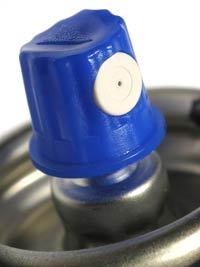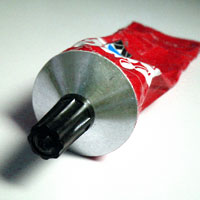Tackling volatile substance abuse in Scotland
a training course for the social care workforce
Course content: Substance recognition
Aerosols

Almost any aerosol has the potential for abuse; this is because aerosols (with some exceptions — see below) use butane as a propellant. It is the propellant rather than the product that gives the effect. As a result of their effect on greenhouse gases, CFCs (Chlorofluorocarbons) have been replaced with butane gas and now this propellant is used in almost all aerosols. Both CFCs and butane are potentially abusable.
- Deodorants
Almost half of aerosol deaths have been associated with deodorants. Some brands appear to be very popularly used. - Other commonly used aerosols
Air fresheners and hairsprays have also resulted in significant numbers of deaths. - Less commonly used aerosols
There have been deaths from aerosols delivering products such as cleaning fluids, insect sprays, paint sprays and adhesives. These again use butane gas as a propellant, but the products themselves may be caustic, acerbic or pungent and not pleasant to inhale. - Nitrous oxide
Nitrous oxide (laughing gas) is used as the propellant in food aerosols such as whipped cream. It is possible to get about 20-30 seconds of propellant gas from an upright whipped cream aerosol and there have been reports of young people using several in a shop. Canisters of nitrous oxide are used in catering for instant whipped cream (domestic versions are commonly available in the USA), in motor racing for enhancing engine performance (home kits are available on the internet) and in medicine as an anaesthetic.
Possessing and inhaling nitrous oxide is entirely legal, although supplying it for purposes other than its intended use is illegal. In the UK it has recently become more popular around the club scene and festival circuit, where it can be obtained in balloons. Re-Solv is currently working with the Medicines and Healthcare products Regulatory Agency (MHRA) to find out more about preventing the abuse of the product.
Methods of use
‘I have seen young people taking aerosols through a towel, you know, spray it into the towel and then breathe in and breathe out. The rush lasts for about ten to fifteen seconds depending on how much you take … I know all this from reading leaflets and watching my friend.’
Quote from a young person looked after in a residential home
The abuse of aerosols often involves towels, socks, rags or tissue paper, which are used as filters. Items used in this way would be seeped in the product and may have white rings formed from the particulate content.
Sometimes aerosols are sprayed into a plastic bag where the product separates out from the propellant. Some products can be abused by inverting the can.
There were 365 deaths from the abuse of aerosols between 1971 and 2004.1 Deodorants were associated with the most deaths, followed by pain relief sprays, air fresheners and hairsprays. Deaths have also resulted from the abuse of cleaning products and insect sprays.
Johnson Wax uses an air-propelled aerosol for some of their products. A practical difficulty in using air as a propellant is that the pressure decreases through the life of the aerosol.
Solvent based glue

Solvent-based adhesives usually contain toluene as the main solvent. They may also contain a range of other solvents and they are usually inhaled from a plastic bag or other container.
The most common solvent-based adhesives are impact (or contact) adhesives (these can be purchased in very large containers), clear glues, model glues, or bicycle puncture repair glues (usually in small tubes).
Death, risk of suffocation on a plastic bag, inhalation of vomit, or trauma are all possible consequences. Long-term glue sniffers may suffer brain damage or damage to other organs. Much of this is reversible once sniffing stops.
Glue sticks to the clothing, hair or face and when in contact with the skin for some time it causes burns. Many, but not all, solvents are flammable. Usually there is a flammable sign on the container. Oil of mustard (Mustard gas) has been added on occasions to solvent-based adhesives. It makes it difficult to work with, especially if it is used commercially, e.g. Formica lamination.
There are water-based alternatives, which are widely used in industry. They require more drying time and are more difficult to use. Superglue contains cyanoacrylate and cannot be sniffed.
Typewriter correction fluid
Many, but not all, now contain relatively heavy solvents. This means that they have little intoxicating effect. There are dry and water-based alternatives. The water-based versions have proved unpopular with users as they make the paper uneven.
Petrol
There were 34 petrol deaths between 1971 and 2004. Re-Solv's records include a number of petrol related burning incidents. This may be because petrol fumes are relatively heavy and do not dissipate very quickly and it is often taken from large containers with a high risk of spilling.
Petrol is a mixture of hydrocarbons and some of these are potentially carcinogenic although Re-Solv has found no reported cases where a connection has been made. If the lungs come into contact with liquid petrol, they produce large amounts of fluid, which can slowly fill the lungs and so can be very dangerous.
Substance recognition – key points
- Cigarette lighter refills are the most common product of abuse
- Butane gas is available in gas lighter refills and is a major constituent of most aerosols
- There are many other products that can be abused including adhesives, typewriter correction fluids, probably 30 or more products in the average home
- Be aware of:
- Products going missing
- Products discarded in unusual places or in large quantities
- Damaged products, especially nozzles
- Towels, socks or rags with white rings or soaked in deodorant
- Many products are flammable and this can be a significant risk especially if the user or their friends smoke
Course content » next section » Risks
- Ramsey, J. et al. (2006) Trends in Deaths Associated with Abuse by Volatile Substance 1971-2004 London: St George’s Hospital Medical School. ↩